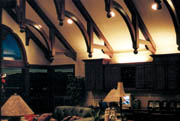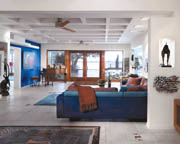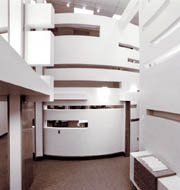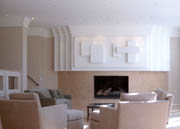

For the 2003 contest, the association received a diverse array of entries exhibiting truly exceptional design and craftsmanship. The panel of judges consisted of gypsum industry and architectural experts, who were charged with selecting the winning projects in both residential and non-residential categories.
Entries must have originated in either the United States or Canada and, for this round, must have been completed during 2003. The projects were judged on complexity, overall effect, quality of workmanship, and innovation-the use of gypsum board in an area where it might not typically be incorporated into a project. Once the winners were selected, the panel of experts chose two additional entries for honorable mention from both the residential and non-residential categories.
"The Excellence in Gypsum Board Design and Construction awards program is one of the best ways to discover and publicize the latest innovative applications for gypsum board that the design community has developed," says the association's Executive Director Michael Gardner.
"We take pride in the fact that not only do we continue to promote innovative ways to use gypsum board, but we also bring some excitement and some reward to those who participate in the program," Gardner says.

Bring out the winners
The entries are submitted by team leaders from the contracting or design firm that coordinated the project or installed the gypsum board. The teams usually consist of the design firm, the general contractor and the drywall contractor. Once the winners from the residential and non-residential categories are selected, each winning entry's team leader receives a check for $3,000 and each company in the team receives a plaque that permanently recognizes their achievement. The team members of the projects receiving honorable mention also receive a commemorative plaque.The 2003 winner in the residential category is the Brown Home, of Cedar Hills, Utah. Steve Perry Construction & Design, of Springville, Utah, designed several innovative architectural features for the Brown Home using gypsum board, and contracted the work to Western States Drywall, of Riverton, Utah. The most eye-catching feature of the project was the treatment of a vaulted ceiling with ornate timbers made primarily of gypsum board.
Team leader Judy Perry explained that the occupants wanted an ornate heavy timber look and that it was more cost effective to construct the beams using a framework of lumber and oriented strand board clad in 1/2- and 3/8-inch thick gypsum board than to use wood timbers. Once assembled, the beams were painted, given a faux wood look and finished with a clear sealer. The only visible wood on the timbers are the alder wood balls hanging from the beams.
"This project is most unusual for a residence," says one of the panel members. "The builder clearly made a deliberate effort to use gypsum board where another material would normally have been installed."
The 2003 winner in the non-residential category was the Providence Continuing Care Centre Mental Health Services Worship Centre, of Kingston, Ontario, Canada. For this project, the design team at Mill and Ross Architects Inc., of Kingston, fashioned a worship center in a mental health facility from an old auditorium. Lead designer Jason-Emery Groën explained that their challenge was to modify the auditorium to create the proper atmosphere for the patients' devotional practices and subdivide it into several distinct sections while still providing sufficient light for the inner main area. Their solution was installing several curved partitions, or radius walls, that contain sleek horizontal slots that allow sufficient light to permeate the entire space of the chapel while still imparting the sense of separation required between the different sections in the chapel.
The general contactor on the project was Emmons & Mitchell Construction, and the drywall contractor was Westbrook Walls & Ceilings, both of Kingston. The judges marveled at the sophistication of these partitions, one stating: "This elegant and spectacular design is innovative and complicated. Also, the framing, the gypsum board installation, and the finishing all exhibit the highest level of craftsmanship and attention to detail."
The Sneaker Villa, in Philadelphia, received honorable mention in the non-residential category. This project used suspended gypsum board figures to create a flagship store where the interior space can be regularly altered. A modern "urban" motif was used to attract shoppers from a wide geographic area and to entice the clientele to return frequently. The project's architecture firm was Meister Architects, of Wyomissing, Pa.; the builder/contractor was Purcell Construction, of Denver, Pa.; and the drywall contractor was Benner and White, of Harleysville, Pa.

With honors
Also receiving honorable mention in the non-residential category was the South-Western Career Academy, in Grove City, Ohio. The project's architecture firm was Steed Hammond Paul, of Hamilton, Ohio, the builder/contractor was Corna/Kokosing Construction Co., of Columbus, Ohio, and the drywall contractor was Maghie & Savage Inc., of Columbus. Gypsum board was used throughout the building to create curved and multifaceted ceilings and bulkheads that add elegance seldom seen in an educational building; the final effect being interior spaces that more resemble a modern office building than a career-technical high school.The Patterson Residence project in Great Falls, Va., received honorable mention in the residential category. This project was submitted by the designer and last year's winner, Verner Svalbe, AIA, of Vienna, Va. The general contractor was

Report Abusive Comment